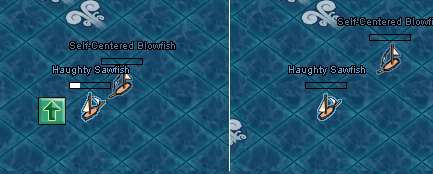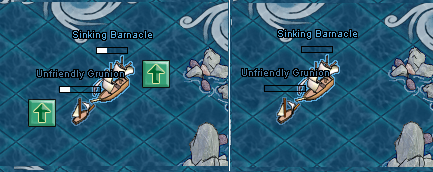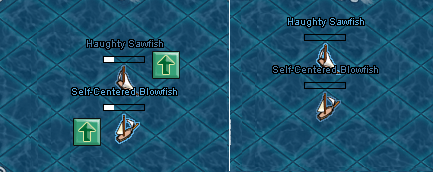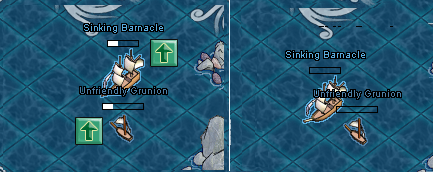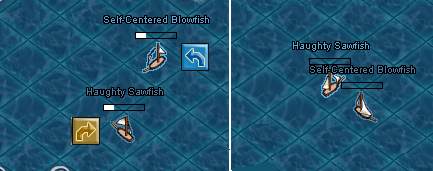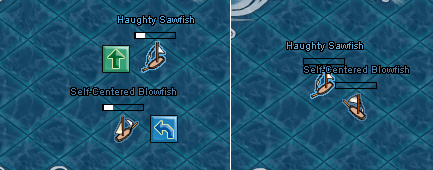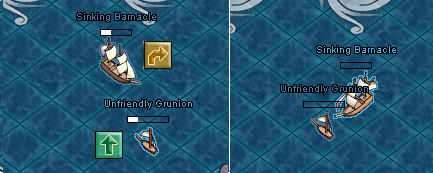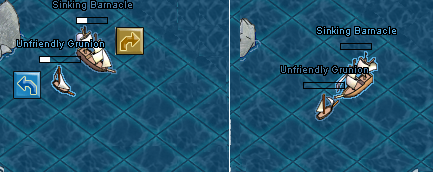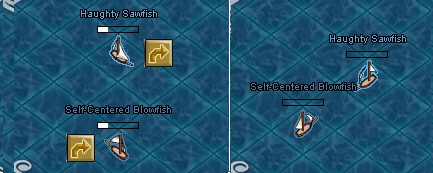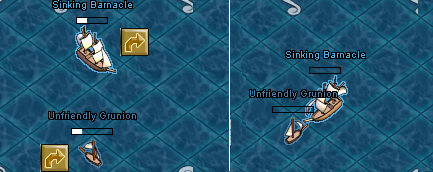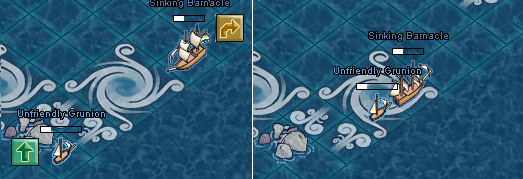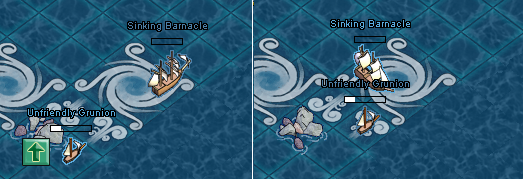Collision mechanics
A collision occurs during sea battle when two ships attempt to occupy the same tile at the same time, either due to movement tokens or due to wind and whirlpools. Since only one ship can occupy each tile, the navigators' desired moves are translated into two moves that do not conflict.
Contents
Collisions during movement
The majority of collisions occur during the movement phase, when movement tokens cause ships to collide.
Concepts
- Ship class is an important concept. Often the results of a collision depend on whether the two ships are of the same class.
| Ship Name | Damage dealt by this ship
(Equivalent hits by shot size) |
Size class | ||
|---|---|---|---|---|
| Small | Medium | Large | ||
| Sloop | 0.5 | 0.333 | 0.25 | Small |
| Cutter | 0.5 | 0.333 | 0.25 | Small |
| Dhow | 0.5 | 0.333 | 0.25 | Small |
| Fanchuan | 0.5 | 0.333 | 0.25 | Small |
| Longship | 0.5 | 0.333 | 0.25 | Medium |
| Baghlah | 1 | 0.667 | 0.5 | Medium |
| Merchant brig | 1 | 0.667 | 0.5 | Medium |
| Junk | 1.5 | 1 | 0.75 | Medium |
| War brig | 2 | 1.333 | 1 | Medium |
| Merchant galleon | 2.5 | 1.667 | 1.25 | Large |
| Xebec | 2.5 | 1.667 | 1.25 | Large |
| War galleon (verify) | Large | |||
| War frigate | 3 | 2 | 1.5 | Large |
| Grand frigate | 4 | 2.667 | 2 | Grand |
- When turning, ships affect the square in front of them as well as their destination space. When navigating a ship with the goal of avoiding all collisions, players should imagine that the ship actually passes through two spaces during each left or right turn, instead of simply moving diagonally.
Collision rules
- 1. All ships that are moving (regardless of direction) attempt to "claim" the space that started directly in front of them. That space has five possibilites:
- a. That space is empty and unclaimed. Then move the ship into that space.
- b. That space contains a stationary ship. Then execute a "bump" (see below).
- c. That space contains a ship that is moving, and claiming the first ship's space. Then stop movement entirely (with a collision).
- d. That space is empty but claimed by a ship of the same or larger class. Then stop movement entirely (with a collision).
- e. That space is empty but claimed by a ship of smaller class. Then move the ship into that space (with a collision).
- 2. All ships that are turning but have not "stopped entirely" then attempt to claim their destination space. Now that space also has five possibilities:
- a. That space is empty and unclaimed. Then move the ship into that space.
- b. That space contains a stationary ship OR a ship that moved there in step 1. Then stop movement entirely (with a collision).
- c. That space contains a ship that is moving, and claiming the first ship's space. Then stop movement entirely (with a collision).
- d. That space is empty but claimed by a ship of the same or larger class. Then stop movement entirely (with a collision).
- e. That space is empty but claimed by a ship of smaller class. Then move the ship into that space (with a collision).
- Note: At the end, all ships have their orientation changed if they tried to turn... even if they had "stopped entirely."
Note that (2b) does not depend on the ship's class. This allows a small ship to move forward into a tile even if a larger ship is attempting to turn into that tile. If two ships both try to move into the same tile for any other reason, the larger ship succeeds.
Bump
A bump occurs when a moving ship attempts to move into or through the tile occupied by a stationary ship.
- If the moving ship is attempting to turn, then neither ship moves, and all motion stops, but the ship attempting to turn changes its orientation.
- If the moving ship is attempting to go forward, then the stationary ship is pushed back by one space, and the moving ship doesn't move.
- If the moving ship is of a smaller class than the stationary ship, neither ship moves.
- Now, if the moving ship is a larger class than the stationary ship, the moving ship occupies the desired tile, and the stationary ship is pushed one tile foreward, so it's still in front of the larger ship (a "push").
Examples
Each of the five cases for step one is illustrated under "Simple Collisions," while each of the five cases for step two is illustrated as "Complex Collisions."
Simple collisions
A simple collision involves only stationary ships and ships placing forward tokens.
Equal Class, Bump
1b. Haughty Sawfish claims a space with a stationary ship, so a "bump" occurs, pushing Self-Centered Blowfish back.
If Haughty Sawfish had been a larger ship, it would have then occupied the former location of Self-Centered Blowfish (a "push").
Direct Conflict
1c. Unfriendly Grunion and Sinking Barnacle claim each others' spaces, so regardless of class, neither ship moves.
Equal Class, Same Destination
1d. Haughty Sawfish and Self-Centered Blowfish both claim the same space. Since they are the same class, neither ship moves.
Different Class, Same Destination
1d. Unfriendly Grunion and Sinking Barnacle claim the same space. Since Unfriendly Grunion is small, it stops movement immediately.
1e. Since Sinking Barnacle is large, it takes control of the space.
Note that the forward move by Sinking Barnacle cannot be stopped; regardless of what Unfriendly Grunion does, it will be exposed to the broadsides of the larger ship.
Complex collisions
Collisions involving turns are more complicated, since each ship goes through two stages of motion.
No Collision
1. Both ships claim the spaces in front of them. Since this is not a conflict, both ships occupy those spaces.
2a. Now both ships look to their destination spaces. Both of these are "empty" in that they do not contain a stationary ship or one that landed there in step 1. So, both ships successfully move to their destination.
Note that both ships "used" Haughty Sawfish's destination tile, but no collision occurred. Situations like this are what gave rise to the "two stages of motion" theory.
Forward Versus Turn
1. Haughty Sawfish claims the spot in front of it, as does Self-Centered Blowfish. Both spaces are empty, so both ships move forward.
2b. Self-Centered Blowfish attempts to claim its destination space, but it is occupied by a ship that finished moving there in step 1. So, it stops and does not complete its move.
Forward Versus Turn II
1. Unfriendly Grunion claims the spot in front of it, and Sinking Barnacle does the same. Both spaces are empty, so both ships move forward.
2b. Sinking Barnacle attempts to claim its destination space, but it is occupied by a ship that finished moving there in step 1 regardless of class. So, it stops and does not complete its move.
Testing all the way up to frigate class verifies that tiny ships moving forward can stop the motion of large ships that are turning.
Turning Head-On
1. Unfriendly Grunion and Sinking Barnacle both claim the spaces in front of them with no conflict. So, they successfully occupy those spaces.
2c. Both ships try to claim their destination space, but those spaces are occupied by ships claiming their current space. Neither ship completes its turn.
Turn Versus Turn
1. Haughty Sawfish and Self-Centered Blowfish both claim the spaces in front of them, neither of which is occupied. So, both ships move forward.
2d. Both ships attempt to claim their destination space, but this space is claimed by two ships of equal class. Neither ship is able to move into that space then, and both ships stop motion one space in front of their start location.
Turn Versus Turn II
1. Unfriendly Grunion and Sinking Barnacle both claim the spaces in front of them, neither of which is occupied. So, both ships move forward.
2d. Unfriendly Grunion claims its destination space, but it is also claimed by Sinking Barnacle, which is of larger class. So, Unfriendly Grunion is unable to finish its move, and stops.
2e. Sinking Barnacle claims its destination space, which is only claimed by a ship of smaller class. So, Sinking Barnacle completes its move unhindered.
Collisions during wind
Each turn of sea battle consists of four rounds, and during each round, ships first move, then are affected by wind. The above examples illustrate what happens during the "move" phase, but not during the "wind" phase, when collisions can also occur. This section describes how collisions work when they are caused by wind instead of by movement tokens.
Concepts
In the movement phase, there are two types of movement ("forward" and "turn") which interact in different ways depending on the classes of the two colliding ships. Similarly, with wind and whirlpools, there are two types of movement: "wind" and "whirl." Wind is caused by a simple tile of wind, which normally pushes a ship one space in one direction on each turn. Whirls are caused by the often-dreaded whirlpools, which normally twist a ship 1/4 clockwise while moving it to the opposite corner.
Luckily, collision rules for wind and whirlpools correspond exactly with collision rules for movement, where a "wind" tile acts just like a "forward" move and a "whirl" action acts just like a "turn" move. This is harder to visualize since the wind happens independent of ships' orientation, but works.
Collision rules
The "theory of collision rules" for movement is copied below, with bold text where changes are made for wind and whirlpools.
- 1. All ships that are moving (regardless of direction) attempt to "claim" the space that they are moving through next. That space has five possibilites:
- a. That space is empty and unclaimed. Then move the ship into that space.
- b. That space contains a stationary ship. Then execute a "bump".
- c. That space contains a ship that is moving, and claiming the first ship's space. Then stop movement entirely (with a collision).
- d. That space is empty but claimed by a ship of the same or larger class. Then stop movement entirely (with a collision).
- e. That space is empty but claimed by a ship of smaller class. Then move the ship into that space (with a collision).
- 2. All ships that are whirling but have not "stopped entirely" then attempt to claim their destination space. Now that space also has two possibilities:
- a. That space is empty and unclaimed. Then move the ship into that space.
- b. That space contains a stationary ship OR a ship that moved there in step 1. Then stop movement entirely (with a collision).
- Cases c, d, and e above never happen with whirlpools.
- Note: At the end, all ships have their orientation changed if they tried to whirl... even if they had "stopped entirely."
Note that (2b) does not depend on the ship's class. This allows a small ship to be pushed by wind into a tile even if a larger ship is attempting to whirl into that tile. If two ships both try to move into the same tile for any other reason, the larger ship succeeds.
Bump
A bump occurs when a moving ship attempts to move into or through the tile occupied by a stationary ship.
- If the moving ship is attempting to whirl, then neither ship moves, and all motion stops, but the ship attempting to whirl still changes its orientation.
- If the moving ship is attempting to move by wind, then the stationary ship is pushed back by one space, and the moving ship doesn't move.
- If the moving ship is of a smaller class than the stationary ship, neither ship moves.
- Now, if the moving ship is a larger class than the stationary ship, the moving ship occupies the desired tile, and the stationary ship is pushed one tile foreward, so it's still in the same direction relative to of the larger ship (a "push").
Examples
Simple collisions
A simple collision involves only stationary ships and ships caught in wind, with no whirlpools involved.
Equal Class, Bump
1b. Big Sild claims a space with a stationary ship, so a "bump" occurs, pushing Dangerous Plaice back.
If Big Sild had been a larger ship, it would have then occupied the former location of Dangerous Plaice (a "push").
Direct Conflict
1c. Big Sild and Dangerous Plaice claim each others' spaces, so regardless of class, neither ship moves.
Equal Class, Same Destination
1d. Big Sild and Dangerous Plaice both claim the same space. Since they are the same class, neither ship moves.
Different Class, Same Destination
If one of the ships had been a larger class, the larger ship would have successfully entered the destination space.
Complex collisions
Collisions involving whirlpools are more complicated, since each ship goes through two stages of motion.
Wind Versus Whirl
(Before 1). Both ships use their movement tokens. Now the wind kicks in.
1. Unfriendly Grunion claims the southern space of the whirlpool, while Sinking Barnacle claims the eastern space. No conflict occurs yet, so both ships move into those locations.
2b. Sinking Barnacle now attempts to claim its destination space, but that space is already occupied by Unfriendly Grunion, a ship that moved there successfully in step 1. Thus, regardless of class, Sinking Barnacle stops in place in the eastern space of the whirlpool.
Wind Versus Whirl II
1d. Big Sild and Dangerous Plaice both claim the northern square of the whirlpool. Since both are the same class, neither can successfully claim it, and both stop entirely.
2. Both ships already stopped. Big Sild simply turns 90 degrees and both ships remain in place.
This is a rather comical thing to test -- both ships stay in place indefinitely, running into each other every turn, but never moving. The ship in the whirlpool spins continuously in place.
Wind Versus Whirl III
(Before 1). Unfriendly Grunion uses its movement token. Now the wind kicks in.
1. Unfriendly Grunion and Sinking Barnacle both claim the southern space of the whirlpool.
1d. Unfriendly Grunion sees a larger ship attempting to claim the same space, so it stops all motion.
1e. Sinking Barnacle sees only a smaller ship attempting to claim that space, so it moves successfully.
2. Sinking Barnacle now claims its destination space and completes its motion.
